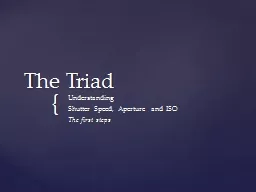PPT-The Triad Understanding
Author : mindeeli | Published Date : 2020-06-24
Shutter Speed Aperture and ISO The first steps A little about Di A little about us Who are we Shutter Speed D etermines how long the shutter will stay open The
Presentation Embed Code
Download Presentation
Download Presentation The PPT/PDF document "The Triad Understanding" is the property of its rightful owner. Permission is granted to download and print the materials on this website for personal, non-commercial use only, and to display it on your personal computer provided you do not modify the materials and that you retain all copyright notices contained in the materials. By downloading content from our website, you accept the terms of this agreement.
The Triad Understanding: Transcript
Download Rules Of Document
"The Triad Understanding"The content belongs to its owner. You may download and print it for personal use, without modification, and keep all copyright notices. By downloading, you agree to these terms.
Related Documents














